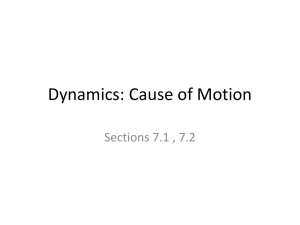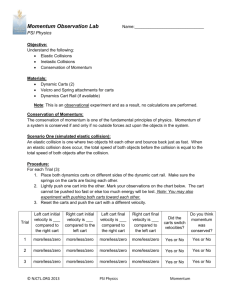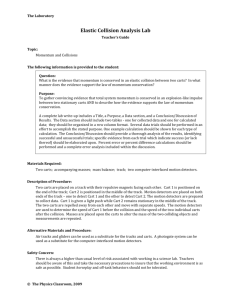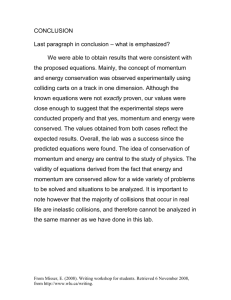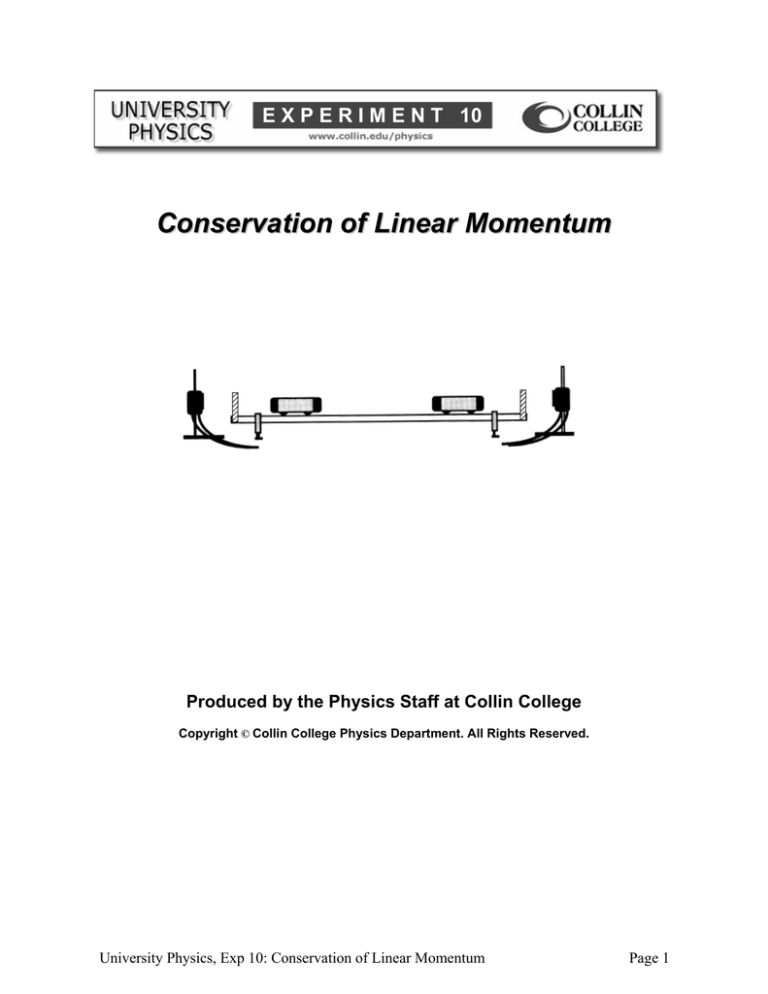
E X P E R I M E N T 10
Conservation of Linear Momentum
Produced by the Physics Staff at Collin College
Copyright © Collin College Physics Department. All Rights Reserved.
University Physics, Exp 10: Conservation of Linear Momentum
Page 1
Purpose
In this experiment you will observe and analyze elastic and inelastic collisions in one
dimension using (almost) frictionless carts on a horizontal track.
Equipment
•
•
•
•
•
1 Track w/ Leveling Feet
1 Plunger Cart w/ Mass
2 Motion Sensors w/ Stands
2 Bumpers
1 Collision Cart w/ Magnets
• 1 Meter stick
• 1 Lab Balance
Introduction
In this experiment you will observe and analyze elastic and inelastic collisions in one
dimension and in two dimensions. You will measure the final momentum of a system after it
explodes. You will see how both kinds of collision affect the kinetic energy of a system that
consists of two frictionless carts. You will determine the momentum of two carts after they
collide when one cart is initially stationary. You will analyze the results qualitatively as well
as quantitatively using a pair of motion sensors. In particular, you will:
1. Verify that the linear momentum of a system is conserved when only internal forces
act on the parts.
2. Learn to use the linear momentum conservation law in the analysis of experimental
situations.
3. Learn to apply the relationships associated with different types of collisions and their
limitations when related to actual experimental settings.
Theory
The simplest explosion is when two objects, originally at rest, push away from each other
because of only a force between the two (a force completely internal to the system). When
only internal forces are exerted, the total momentum of a system is conserved. Because the
system is initially at rest, its initial momentum, pi, is zero. The final momentum of the system,
pf, must still be zero. The final momentum of each object, therefore, must be equal in
magnitude and opposite in direction.
pi = p f = p1 + p2 = 0
p1 f = m1v1 f = − p2 f = −m2v2 f
Therefore, the ratio of the final velocities of the two objects is equal to the negative inverse
ratio of their masses:
v1
m
=− 2
v2
m1
University Physics, Exp 10: Conservation of Linear Momentum
Page 2
The velocity ratio is a negative number because v1 and v2 are in opposite directions.
We can verify the latter equation by measuring the masses and final velocities of two lowfriction carts on a track. There are two ways to measure the final velocities: you could
measure each velocity directly with a motion sensor at each end of the track, or you could
measure the distance each cart moves during the same time interval. You will use both
methods in this experiment.
In the latter method, if you measure the after-collision distance each cart goes during the same
time interval, the ratio of their speeds will equal the ratio of the distances they travel:
v1 Δx1
=
v2 Δx2
By eliminating the velocity ratio between these two equations, we discover that the ratio of
their travel distances is equal to the inverse ratio of their masses:
Δx1 m2
=
Δx2 m1
in which all the quantities are easily measurable.
A collision is an explosion in reverse time. When two objects collide, either elastically or
inelastically, the total momentum of both objects is always conserved. The sum of the initial
momentum of the two objects is always equal to the sum of their final momentum.
The total kinetic energy of both objects, however, is not always conserved. An elastic
collision is defined as one in which the total kinetic energy is conserved, i.e., they bounce off
each other with no net loss of kinetic energy. An inelastic collision, of course, is one in which
the kinetic energy of the system is not conserved. In an inelastic collision, some of the initial
kinetic energy goes into deforming the objects. In most inelastic collisions, the deformed
objects separate after the collision, but in a perfectly inelastic collision, they stick together.
In this experiment, you will make two carts collide elastically by using their repelling
magnetic bumpers (or spring plungers). The collision will be elastic as long as the carts
rebound without touching. You will then make the carts undergo a completely inelastic
collision (sticking together) by using Velcro bumpers.
A collision is one dimensional when the direction of one object’s initial velocity passes
through the other object’s center of mass. After such a collision, the objects move away from
each other along this same line. If the initial velocity does not pass through the center of mass,
the objects will move away in different directions, making the collision two dimensional.
Being a vector quantity, momentum can be resolved into components. For a system’s total
momentum to be conserved, each of its components must be conserved.
University Physics, Exp 10: Conservation of Linear Momentum
Page 3
If a moving object has a collision with a stationary object, the initial momentum of the system
is equal to that of the moving object. The vector sum of the final momentum of both objects
will be equal to this initial value, whether the collision is elastic or inelastic, and whether it is
one-dimensional or two-dimensional.
Consider a two-dimensional collision between two steel balls. Ball m1 is initially at rest (so vi1
= 0) and ball m2 moves toward it with velocity vi2. After they collide, both balls move off with
velocities vf1 and vf2. To resolve the velocities into their components, let the x axis be parallel
to vi2, as shown in Figure 10.1.
The initial and final momentum of the two-ball system is pi = m2vi2 = pf. Since the initial
momentum is along the x axis,
pxi = pxf = m2v2xi
and
pyi = pyf = 0
and
m1v1yf + m2v2yf = 0
Therefore,
m1v1xf + m2v2xf = m2v2xi
If the two balls have equal mass, m1 = m2, then
v1xf + v2xf = v2xi
and
v1yf = – v2yf
Using the method that led to the distance/mass ratio equation, we can make the times of their
final motions equal and determine vf1 and vf2 simply by measuring df1 and df2. To make the
times equal, let the initial momentum be horizontal and let them collide a short height above
the table. Both balls will then fall to the table in the same time. If the collision is elastic,
kinetic energy is also conserved, so
1
1
1
m2 v22i = m1v12f + m2 v22 f
2
2
2
2
2
2
or v2i = v1 f + v2 f
University Physics, Exp 10: Conservation of Linear Momentum
Page 4
Procedure
You will use various techniques to investigate how well momentum is conserved in a system
of two low-friction carts when they explode away from each other and also when they
undergo both elastic and inelastic 1-D collisions.
A. Linear Momentum in Explosions
The motion sensors are not used in this part.
1. Attach the leveling feet about 25 cm in from each end of the track, then attach the
bumpers very close to each end. Record the scale position of the inside face of each
bumper under Table 10.1. Set the track on the table and level it by using a cart as a
level indicator.
2. Weigh each cart and record its mass in Table 10.1. Calculate and record the ratio of
the masses.
3. Cock the plunger of one cart and place the carts near the center of the track with the
plunger touching the other cart. Note the starting position of each cart (the point on the
track scale directly under the outer face of the cart). Push the plunger release button
with a short stick (not with your hand) and see if the two carts hit the opposite
bumpers simultaneously. To equalize the two travel times, try different starting
positions until the two carts hit their bumpers at the exact same time on two
consecutive trials. Record the starting position of each cart in Table 10.1.
4. Calculate and record the distance traveled by each cart from its starting position to its
bumper and also the ratio of the two distances in Table 10.1.
5. Calculate and record the percent difference between the measured mass ratio and the
calculated mass ratio in Table 10.1.
6. Put one black mass bar (500 g) in cart #1 and repeat steps 2 – 5. Note: the starting
points will be different. Record your results in Table 10.1.
7. Put two mass bars in cart #1 and repeat steps 2 – 5. Record your results in Table 10.1.
8. Put two mass bars in cart #1 and one in cart #2 and repeat steps 2 – 5. Record your
results in Table 10.1.
B. Linear Momentum in 1-D Collisions
1. With the power switched off, connect two Motion Sensors to the four Digital
Channels. The motion sensor cables must be connected to the digital channels in the
correct order (check with your instructor). Mount each motion sensor on its stand.
Switch on the computer system, open Data Studio, and select Create Experiment.
Open two Motion sensors. Double-click on the Motion sensor icon to open Sensor
Properties. Select the Motion Sensor tab and set the Trigger Rate to 25.
University Physics, Exp 10: Conservation of Linear Momentum
Page 5
2. Open a Graph display window and select Position, Ch. 1&2 (m). Open a second Graph
display window and select Position, Ch. 3&4 (m). Both graphs plot position vs. time.
3. Level the track as you did in Part A.
4. Cut the bottoms from two Styrofoam cups and tape a cup onto each motion sensor to
form a small megaphone for the sensor window. Place the motion sensors on their
stands about 40 cm beyond each end of the track as shown in Figure 10.1. Orient each
sensor to look straight down the track toward each other. Place a cart at each end of
the track.
5. Keep all other possible targets, such as your bodies, behind the sensors and aim each
sensor so it measures only the motion of its cart as both carts move back and forth on
opposite ends of the track. Remember that the minimum distance the sensor will
measure is 40 cm.
The analysis in Part B involves measuring the slopes of the Position versus Time plots which
are the average speeds of the carts. You will measure the speed of each cart both before and
after they collide. Then you will calculate and compare the total momentum of the two-cart
system both before and after the collision.
BA. Elastic Collisions
1. Orient the two carts at each end so their magnetic bumpers (or spring plungers) are
toward each other. Click Start, then simultaneously and gently push each cart, and
watch the data on the two plots. If the carts actually touch (their surfaces bang
together), you have pushed them too hard. To get a true elastic collision, their
magnetic fields (or spring plungers) must keep them apart. Click Stop after each cart
returns to its end.
2. If the two plots are not smooth, check the alignment of the motion sensors. This
alignment is touchy. The narrow ultrasound beam emitted by each sensor should
reflect only from the nearer cart. You may need to increase the reflecting area of the
carts by taping an index card to its end facing the sensor. Delete all your test data runs.
BAa. Carts of equal mass
3. Weigh each cart and record its mass in Table 10.2.
4. Run each of the three cases below, then drag-select the region of the plot that shows
cart #1’s motion before the collision. Do the same for cart #2’s plot. Then click the Fit
button on each graph and select Linear Fit. The slope in the linear fit equation is the
average speed of each cart before they collide.
5. Record the average pre-collision velocity of each cart (v1i and v2i) in Table 10.2.
Calculate and record the average initial momentum of each cart (p1i and p2i).
Remember that momentum is a vector quantity so the momentum of one of the carts
will be negative due to its direction of motion.
6. Repeat step 4 for the regions that show the carts’ motions after the collision.
7. Repeat step 5 for the post-collision values of velocity and momentum.
8. Calculate and record the total momentum of the system before and after the collision
in Table 10.2. Calculate and record the percent difference between the total initial and
final momentum of the system in Table 10.2.
University Physics, Exp 10: Conservation of Linear Momentum
Page 6
Case 1: Cart #1 initially at rest at the center of the track. Cart #2 starts at the end with an
initial velocity toward cart #1.
Case 2: Carts at each end of the track. Each cart starts with about the same initial velocity
toward the other.
Case 3: Both carts at the same end of the track. Cart #1 starts with a slow velocity, then cart
#2 starts with a faster velocity so it bumps cart #1 from behind.
9. Draw two velocity vector diagrams (one for before the collision and one for after the
collision) for each of the three cases. In each diagram, show the velocity vector for
each cart with a length that approximately represents the relative speed of the cart.
BAb. Carts of unequal mass
10. Place two mass blocks in cart #1. Weigh the cart and record its new mass in Table
10.2.
11. Repeat steps BAa 4 – 8 for each of the five cases below. Record your results in Table
10.2.
Case 1: Cart #1 initially at rest at the center of the track. Cart #2 starts at the end with an
initial velocity toward cart #1.
Case 2: Cart #2 initially at rest at the center of the track. Cart #1 starts at the end with an
initial velocity toward cart #2.
Case 3: Carts at each end of the track. Each cart starts with about the same initial velocity
toward the other.
Case 4: Both carts at the same end of the track. Cart #1 starts with a slow velocity, then cart
#2 starts with a faster velocity so it bumps cart #1 from behind.
Case 5: Both carts at the same end of the track. Cart #2 starts with a slow velocity, then cart
#1 starts with a faster velocity so it bumps cart #2 from behind.
BB. Perfectly Inelastic Collisions
1. Orient the two carts at each end so their Velcro bumpers are toward each other. Make
sure the plunger bar is pushed in completely. Click Start, then simultaneously and
gently push each cart, and watch the data on the two plots. If the carts do not hit and
stick together, try again. Click Stop after the combined carts reach the bumper.
2. Practice to get plots that are smooth and with the two carts sticking together. If
necessary, use the techniques described in step BA2 to get continuous plots. Delete all
your test data runs.
BBa. Carts of equal mass
3. Repeat steps 4 - 8 in Part BAa. Record your results in Table 10.3.
BBb. Carts of unequal mass; two mass bars in cart #1
4. Repeat steps 10 and 11 in Part BAb. Record your results in Table 10.3.
5. Quit Data Studio and switch off the computer system. Disconnect the motion sensors,
neatly coil and tie the sensor cables. Disassemble the track, feet, and bumpers and set
them aside.
University Physics, Exp 10: Conservation of Linear Momentum
Page 7

